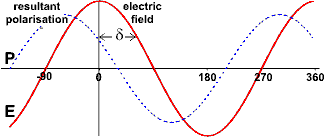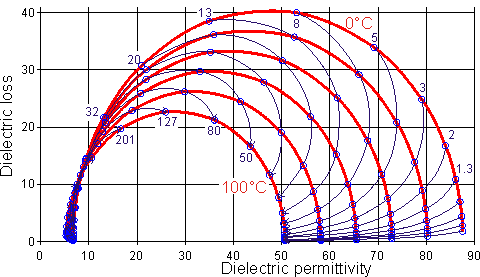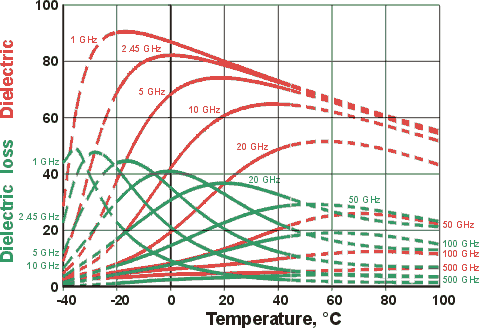Water
Dielectric and Microwave Radiationa
The water dipoleb attempts
to continuously reorient in electromagnetic radiation's oscillating
electric field (see external
applet). Dependent on the frequency the dipole may move in time
to the field, lag behind it or remain apparently unaffected. When
the dipole lags behind the field then interactions between the dipole
and the field leads to an energy loss by heating, the extent of
which is dependent on the phase difference of these fields; heating
being maximal twice each cycle [455].
The ease of the movement depends on the viscosity and the mobility
of the electron clouds. In water these, in turn, depend on the strength
and extent of the hydrogen bonded network. In free liquid water
this movement occurs at GHz frequencies (microwaves) whereas in
more restricted 'bound' water it occurs at MHz frequencies (short
radiowaves) and in ice at kHz frequencies (long radiowaves). The
re-orientation process may be modeled using a 'wait-and-switch'
process where the water molecule has to wait for a period of time
until favorable orientation of neighboring molecules occurs and
then the hydrogen bonds switch to the new molecule [343].
Microwave heating has been modeled using the TIP4P-FQ potenial [570].
The applied field potential (E, volts) of electromagnetic radiation
is given by;
E = Emax.cos(ωτ)
where Emax is the amplitude of the potential, ω is the angular frequency in radians.second-1 and t is
the time (seconds). If the polarization lags behind the field by
the phase (δ,
radians)
then the polarization (P, coulombs) varies
as
P = Pmax.cos(ωt
- δ)
where Pmax is the maximum value of
the polarization. |
 |
Hence the current (I, amperes) varies as
I = (dP/dt) = -ωPmax.sin(ωτ
- δ)
The power (P, watts) given
out as heat is the average value of (current x potential). This
is zero if there is no lag (i.e. if δ = 0), otherwise
P = 0.5 PmaxEmaxω.sin(δ)
It is convenient to express the dielectric constant
in terms of a complex number (εr*, complex dielectric permittivity) defined as:
εr* = εr´
- iLf
Where εr´ is the ability
of the material to be polarized by the external electric field, Lf (the loss factor) quantifies the efficiency
with which the electromagnetic energy is converted to heat and i
=  . This equation may be visualised
by considering the total current is the vector sum of the charging
current and the loss current; the angle δ as the phase difference (lag) between the electric field and the
resultant (orientation) polarisation of the material (see similar
treatment in rheology). . This equation may be visualised
by considering the total current is the vector sum of the charging
current and the loss current; the angle δ as the phase difference (lag) between the electric field and the
resultant (orientation) polarisation of the material (see similar
treatment in rheology).
tan(δ)
= loss current/charging current = Lf/εr´
(see derivation) |
|
The terms (εr*, εr´, Lf ) are all affected by the frequency of radiation;
the relative permittivity (εr´,
dielectric constant) at low frequencies (εS,
static regiond) and
at high ( visible) frequencies the (ε∞,
optical permittivity) are the limiting values. The relative permittivity
changes with the wavelength (and hence frequency):

where εS is the relative
permittivity at low frequencies (static region), and λS is the critical wavelength (maximum dielectric loss).
 (see more on complex dielectric permittivity)
(see more on complex dielectric permittivity)
where τ is the relaxation time (a measure of the time required for
water to rotate ( where
r is the molecular radius, k is the Boltzman constant and η is the viscosity), also considered
as the delay for the particles to respond to the field change,
or for reversion after disorientation. The maximum loss occurs
when ω = 1/τ c. For water at 25°C, τ is
8.27 ps and r is half the (diffraction-determined) inter-oxygen
distance (1.4 Å). where
r is the molecular radius, k is the Boltzman constant and η is the viscosity), also considered
as the delay for the particles to respond to the field change,
or for reversion after disorientation. The maximum loss occurs
when ω = 1/τ c. For water at 25°C, τ is
8.27 ps and r is half the (diffraction-determined) inter-oxygen
distance (1.4 Å).
|
Figure 1. Dielectric permittivity
and dielectric loss of water between 0°C and 100°C,
the arrows showing the effect of increasing temperature
(data is indicative only but based on [64, 135]; exact
data is plotted below)
or increasing water activity.
The wavelength range 0.01 - 100 cm is equivalent to 3 THz - 0.3 GHz
respectively. As the temperature increases, the strength and extent of
the hydrogen bonding both decrease. This (1) lowers both the static and
optical dielectric permittivities, (2) lessens the difficulty for the
movement dipole and so allows the water molecule to oscillate at higher
frequencies, and (3) reduces the drag to the rotation of the water
molecules, so reducing the friction and hence the dielectric loss. Note
that ε∞ (i.e. the dielectric permittivity at short wavelengths) does not change significantly with temperature. Most of the dielectric
loss is within the microwave range of electromagnetic
radiation (~1 - ~300 GHz, with wavenumber 0.033 cm-1 - 10 cm-1, and wavelength 0.3 m - 1.0 mm respectively). The frequency for maximum
dielectric loss lies higher than the 2.45 GHz (wavenumber 0.0817
cm-1, wavelength 12.24 cm) produced by most microwave ovens.
This is so that the radiation is not totally adsorbed
by the first layer of water it encounters and may
penetrate further into the foodstuff, heating it more
evenly; unabsorbed radiation passing through is mostly
reflected back, due to the design of the microwave
oven, and absorbed on later passes.
The
above data can also be plotted using a Cole-Cole plot, as opposite, of
the dielectric permittivity versus the dielectric loss. The red
circular arcs show the effects of temperature varied by 20°C amounts
from O°C to 100°C, whereas the blue lines shows the variation with
temperature at fixed wavelengths (1.3 - 201 GHz).  |
 |

|
Note that the shifts in the dielectric properties
with temperature gives rise to maxima
in the temperature behavior at constant frequency.
Plotted opposite are equations derived for
pure water over the range for -20°C ~ +40°C
[683],
extrapolated (dashed lines) to indicate trends.
The equations that generate these curves involve
15 optimized parameters. Further data has been published [1185].
The temperature effect on the dielectric relaxation time is shown on another page. |
|
The dielectric loss factor (Lf) increases
to a maximum at the critical frequency.
Dissolved salt depresses the dielectric constant dependent on its
concentration (C ) and the average hydration number of the individual
ions (HN)

The dielectric loss is increased by a factor that depends on the
conductivity (Λ, S cm2 mol-1;
S = siemens = mho), concentration and frequency. It increases with
rise in temperature and decreasing frequency.

Ensuring that all units are SI,
the 1000 factor in the denominator goes. This 1000 is a conversion
between SI and cm, mol, L units. This emphasises that careful consideration
must be given to the units used in the microwave literature.
Bound water and ice have critical frequencies (λS)
at about 10 MHz (τ about 0.1 μ)
with raised static dielectric permittivities (εS).
At the much higher frequency of microwave ovens such water has a
low dielectric permittivity (e.g. ice-1h, ε∞ = 3.1; cf. ice-1h, εS = 97.5 [94]; εS water (0°C) = 87.9), and is almost transparent,
absorbing little energy. This is particularly noticed on thawing
where the thawed material may get very hot whilst unthawed material
stays frozen. Therefore for balanced heating the thermal effects
must be evenly distributed, i.e. there should not be pockets
of salty water within a poorly conducting matrix.
The electromagnetic penetration is infinite in a perfectly transparent
substance and zero in reflective material (e.g. metals).
At the microwave oven frequency (2.45 GHz), most energy is absorbed
by water. The attenuation (α) is given
by:

This equation may be approximated where the attenuation is (approximately)
directly proportional to the loss factor and inversely proportional
to the wavelength times the square root of the relative dielectric
constant:

For a plane wave, incident microwaves decrease to 1/e (0.36788; i.e. 63% absorbed) in a penetration distance Dp given approximately
by::
Thus, using water at 25°C, εr´
= 78. Lf
=12, tanδ = 0.15 and Dp = 1.4 cm but the effect is much greater in
supercooled water (that may be present in frozen food) where at
-17.78°C (i.e. 0°F), εr´
= 74.4. Lf =40.1, tanδ =
0.54 and Dp = 0.43 cm [1074].
The amount of power (P, in watts m-3) that is absorbed
is given by:
P = 2πfε0LfE2
where ε0 = 8.854x10-12 F m-1, f is the frequency (Hz, = ω/2π)
and E is the potential gradient (V m-1).
a Background theory and
definitions are given on another
page, as is dielectric spectroscopy.
[Top]
b Hydroxyl groups in sugars
and polysaccharides behave similarly, creating a high shear environment.
Fats exhibit a lesser effect but their lower specific heat gives
rise to rapid heating. [Back]
c Note the relaxation time
is the reciprocal of the frequency in radians per second whereas
the electromagnetic frequency is commonly reported in cycles per
second (Hz). [Back]
d The change of static
permittivity with temperature (-35°C < t < 100°C)
may be approximated by the equation εS(t)=A.e-bt where A= 87.85306 and b=0.00456992 [588].
[Back]
|